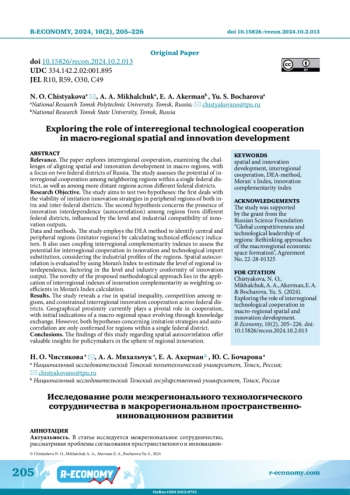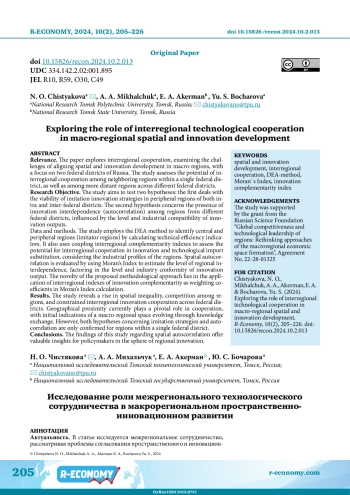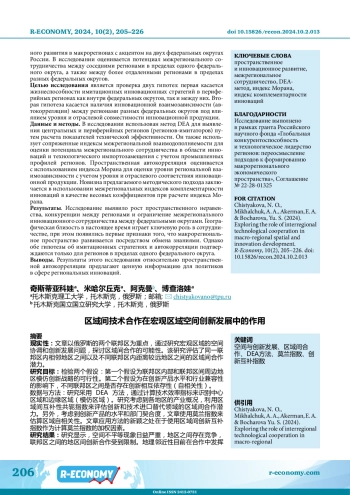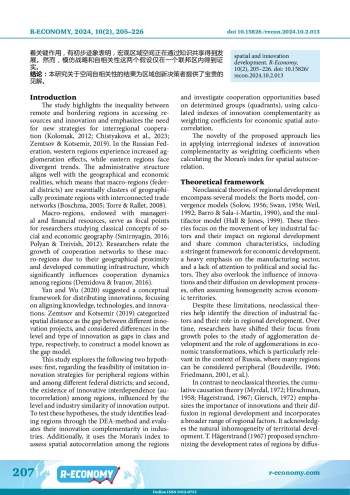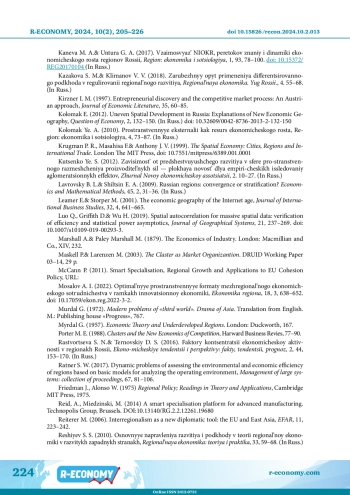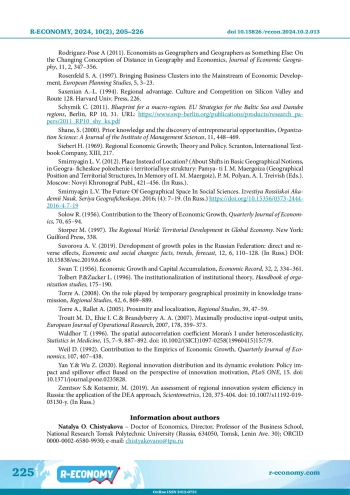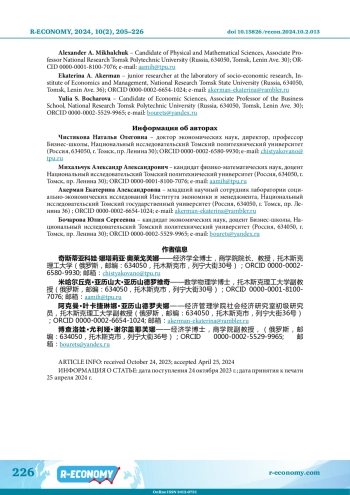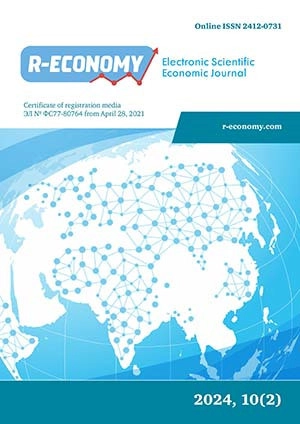Relevance. The paper explores interregional cooperation, examining the challenges of aligning spatial and innovation development in macro-regions, with a focus on two federal districts of Russia. The study assesses the potential of interregional cooperation among neighboring regions within a single federal district, as well as among more distant regions across different federal districts. Research Objective. The study aims to test two hypotheses: the first deals with the viability of imitation innovation strategies in peripheral regions of both intra and inter-federal districts. The second hypothesis concerns the presence of innovation interdependence (autocorrelation) among regions from different federal districts, influenced by the level and industrial compatibility of innovation outputs. Data and methods. The study employs the DEA method to identify central and peripheral regions (imitator regions) by calculating technical efficiency indicators. It also uses coupling interregional complementarity indexes to assess the potential for interregional cooperation in innovation and technological import substitution, considering the industrial profiles of the regions. Spatial autocorrelation is evaluated by using Moran’s Index to estimate the level of regional interdependence, factoring in the level and industry conformity of innovation output. The novelty of the proposed methodological approach lies in the application of interregional indexes of innovation complementarity as weighting coefficients in Moran’s Index calculation. Results. The study reveals a rise in spatial inequality, competition among regions, and constrained interregional innovation cooperation across federal districts. Geographical proximity currently plays a pivotal role in cooperation, with initial indications of a macro-regional space evolving through knowledge exchange. However, both hypotheses concerning imitation strategies and autocorrelation are only confirmed for regions within a single federal district. Conclusions. The findings of this study regarding spatial autocorrelation offer valuable insights for policymakers in the sphere of regional innovation.
Идентификаторы и классификаторы
The study highlights the inequality between remote and bordering regions in accessing resources and innovation and emphasizes the need for new strategies for interregional cooperation (Kolomak, 2012; Chistyakova et al., 2023; Zemtsov & Kotsemir, 2019). In the Russian Federation, western regions experience increased agglomeration effects, while eastern regions face divergent trends. The administrative structure aligns well with the geographical and economic realities, which means that macro-regions (federal districts) are essentially clusters of geographically proximate regions with interconnected trade networks (Boschma, 2005; Torre & Rallet, 2008).
Список литературы
1. Ackerman E. N., Mikhalchuk A. A., Spitsyn V. V., Chistyakova N. O. (2019). Assessing the imitation potential of IT companies using the Cobb-Douglas production function, Bulletin of NSUEU, 4, 130-142. (In Russ.). DOI: 10.34020/2073-6495-2019-4-130-142 EDN: JFKGPR
2. Anisimkova N. D. (2017). Rol’ sektora vysshego obrazovaniya v stimulirova-nii innovatsionnogo protsessa v promyshlennosti, Omskogo universiteta. Seriya “Ekonomika”, 1, 57, 5-12. (In Russ.).
3. Anokhin S., Wincent J., Ylinenpää H. (2015). Technological Expansions, Catching-Up Innovations and Technological Shifts at the Regional Level: Conceptual Considerations and Empirical Illustration, Taylor & Francis Journals, 50, 8, 1433-1448,. DOI: 10.1080/00343404.2015.1027886
4. Averina L. M., Sirotin, D. V. (2020). Assessment of spatial effects from innovative activity of industrialized regions of the Russian Federation, Regional Economics, 16, 1, 268-282. 10.17059/2020-1-20 (In Russ.). DOI: 10.17059/2020-1-20(InRuss.)
5. Barro R., Sala-i-Martin X. (1990). Economic growth and convergence across the United States, NBER Working paper, 272.
6. Batrasova A. D., Konovalova T. V., Komarov P. I. (2022). Assessing the effectiveness of innovative activities of the subjects of the Federation. Bulletin of the Altai Academy of Economics and Law, 11-3, 389-395. (In Russ.). DOI: 10.17513/vaael.2578 EDN: ECCBAF
7. Becattini G. (1962). Il concetto d’industria e la teoria del valore. Torino: Boringhieri. 194.
8. Berkowitz D., DeJong D. N. (2005). Entrepreneurship and Post-Socialist Growth, Oxford Bulletin of Economics and Statistics, 67, 1, 25-46. DOI: 10.1111/j.1468-0084.2005.00108.x EDN: LXRVKR
9. Borts G. H., Stein J. I. (1964). Economic Growth in a Free Market. New York, London, 235.
10. Boschma R. A. (2010). Proximity and Innovation: a Critical Assessment, Regional Studies, 39, 61-74. DOI: 10.1080/0034340052000320887
11. Boudeville J.-R. (1966). Problems of Regional Economic Planning. Edinburgh: Edinburgh University Press, 192.
12. Burets Y. S. (2018). Assessment of innovative complementarity of regions, Economic environment, 3, 25, 40-49. (In Russ.).
13. Caniëls M., Verspagen B. (2003). Spatial Distance in a Technology Gap Model. In B. Fingleton (Eds.), European Regional Growth. Advances in Spatial Science (pp. 159-182). Springer, Berlin, Heidelberg. DOI: 10.1007/978-3-662-07136-6_6
14. Carluer F., Sharipova E. (2004). The Unbalanced Dynamics of Russian Regions: Towards a Real Divergence Process, East-West Journal of Economics and Business, 7, 1, 11-37.
15. Chistyakova N., Mikhalchuk A., Bocharova Y., Akerman E., Tatarnikova V. (2023). Catching-up regional strategy as a tool to reduce spatial inequality, Journal of the Geographical Institute “Jovan Cvijić” SASA, 73, 1, 33-48,. DOI: 10.2298/IJGI2301033C EDN: NZKPKM
16. Combes P.-P., Lafourcade M., Thisse J.-F., Toutain J.-C. (2011). The Rise and Fall of Spatial Inequalities in France: A Long-run Perspective, Exploration of Economic History, 48, 2, 243-271. DOI: 10.1016/j.eeh.2010.12.004
17. Demidova O. A., Ivanov D. S. (2016). Modeli ekonomicheskogo rosta s neodnorodnymi prostranstvennymi effektami (na primere rossiyskikh regionov) [Models of Economic Growth with Heterogenous Spatial Effects: The Case of Russian Regions], Ekonomicheskiy zhurnal VShE [The HSE Economic journal], 20, 1, 52-75. (In Russ.).
18. Dzyubenko I. B. (2021). Assessing the effectiveness of innovative systems in Russian regions using the method of shell data analysis (DEA). Economics and Entrepreneurship, 11(136), 442-450. DOI: 10.34925/EIP.2021.11.136.088 EDN: KUKEGA
19. EMISS (2024) Federal State Statistic Base of Data, https://www.fedstat.ru.
20. Enright M. J. (1992). Why Clusters are the Way to Win the Game? Word Link, 5, July/August, 24-25.
21. Fiani R. (1984). Increasing Returns, Non-Traded Inputs and Regional Development, Economic Journal, 94, 374, 308-323.
22. Friedmann J. (2001). Regional Development and Planning: The Story of a Collabo-ration, International Regional Science Review, 24, 3, 386-395. EDN: JMSDTX
23. Fritsch M. (2003). Does R&D-cooperation behavior differ between regions? Industry and Innovation, 10, 1, 25-39.
24. Fritsch M., Lukas R. (1999). Innovation, cooperation, and the region, In D. B. Audretsch, R. Thurik (Eds.), Innovation, Industry Evolution and Employment (pp. 157-181). Cambridge: Cambridge University Press.
25. Gaddy C. G., Hill F. (2003). The Siberian Curse: How Communist Planners Left Russia Out in the Cold. Washington, DC: Brookings Institution Press, 240.
26. Gareev T. R., Peker I. Yu., Kuznetsova T. Yu., Eliseeva N. A.(2023). Dynamic analysis of the operating environment in assessing the effectiveness of the research sector of Russian regions. Baltic region. 15, 2, 82-102. (In Russ.). DOI: 10.5922/2079-8555-2023-2-5 EDN: LSBOOV
27. Giersch H. (1979). Aspects of growth, structural change, and employment a schumpeterian perspective, Review of World Economics (Weltwirtschaftliches Archiv), 115, 4, 629-652. EDN: YAEVIK
28. Gohberg L. M. (2017) Raiting innovazionnogo razvititya subiektov rossoiskoy federazii, 260 с (In Russ.). ISBN: 978-5-7598-1591-4
29. Granberg A. G. (2006). Idei Avgusta Losha v Rossii, Prostranstvennaya ekonomika, 2, 5-22. (In Russ.).
30. Granberg A. G. (2009). O programme fundamental’nykh issledovaniy prostran-stvennogo razvitiya Rossii, Region: ekonomika i sotsiologiya, 12, 166-178. (In Russ.).
31. Griliches Z. (1979). Issues in assessing the contribution of R&D to productivity growth, Bell Journal of Economics, 10, 1, 92-116.
32. Hagerstrand T. (1967). Innovation Diffusion as a Spatial Process. Chicago: University of Chicago Press, 334.
33. Hall R., Jones Ch. (1999). Why Do Some Countries Produce So Much More Output per Woker than Others? Quarterly Journal of Economics, CXIV, 83-116.
34. Herzfeld T. (2008).Interregional Income Distribution: A Comparison of Russian and Chinese Experience, Post-Communist Economies, 20, 4, 431-447.
35. Hirschman A. (1958). The Strategy of Economic Development, Yale University Press, New Haven, 217. DOI: 10.2307/1235188
36. Jackson M. C., Huang L., Xie Q., Tiwari R. C. (2010). A modified version of Moran’s I.International Journal of Health Geographics, 9. DOI: 10.1186/1476-072X-9-33
37. Kaneva M. A., Untura G. A. (2017). Vzaimosvyaz’ NIOKR, peretokov znaniy i dinamiki ekonomicheskogo rosta regionov Rossii, Region: ekonomika i sotsiologiya, 1, 93, 78-100. (In Russ.). DOI: 10.15372/REG20170104 EDN: YGFNZB
38. Kazakova S. M., Klimanov V. V. (2018). Zarubezhnyy opyt primeneniya differentsirovannogo podkhoda v regulirovanii regional’nogo razvitiya, Regional’naya ekonomika. Yug Rossii., 4. 55-68. (In Russ.).
39. Kirzner I. M. (1997). Entrepreneurial discovery and the competitive market process: An Austrian approach, Journal of Economic Literature, 35, 60-85. EDN: CLXKDF
40. Коломак Е. Неравномерное пространственное развитие в России: объяснения новой экономической географии // Вопросы экономики. - 2013. - № 2. - С. 132-150. DOI: 10.32609/0042-8736-2013-2-132-150 EDN: PVDKRX
41. Kolomak Ye. A. (2010). Prostranstvennyye eksternalii kak resurs ekonomicheskogo rosta //Region: ekonomika i sotsiologiya. 4. 73-87. (In Russ.). EDN: NCZCNT
42. Krugman P. R., Masahisa F., Anthony J. V. (1999). The Spatial Economy: Cities, Regions and International Trade. London The MIT Press,. DOI: 10.7551/mitpress/6389.001.0001
43. Kutsenko Ye. S. (2012). Zavisimost’ ot predshestvuyushchego razvitiya v sfere pro-stranstvennogo razmeshcheniya proizvoditel’nykh sil - plokhaya novost’ dlya empiri-cheskikh issledovaniy aglomeratsionnykh effektov, Zhurnal Novoy ekonomicheskoy assotsiatsii, 2. 10-27. (In Russ.).
44. Lavrovsky B. L., Shiltsin E. A. (2009).Russian regions: convergence or stratification? // Economics and Mathematical Methods, 45, 2, 31-36. (In Russ.). EDN: JXOYBX
45. Leamer E., Storper M. (2001). The economic geography of the Internet age, Journal of International Business Studies, 32, 4, 641-665. EDN: DQAVMR
46. Luo Q., Griffith D., Wu H. (2019). Spatial autocorrelation for massive spatial data: verification of efficiency and statistical power asymptotics, Journal of Geographical Systems, 21, 237-269. DOI: 10.1007/s10109-019-00293-3 EDN: NUFVHA
47. Marshall A., Paley Marshall M. (1879). The Economics of Industry. London: Macmillian and Co., XIV, 232.
48. Maskell P., Larenzen M. (2003). The Claster as Market Organizantion. DRUID Working Paper 03-14, 29 p.
49. McCann P. (2011). Smart Specialisation, Regional Growth and Applications to EU Cohesion Policy, URL.
50. Mosalov A. I. (2022). Optimal’nyye prostranstvennyye formaty mezhregional’nogo ekonomicheskogo sotrudnichestva v ramkakh innovatsionnoy ekonomiki, Ekonomika regiona, 18, 3, 638-652. DOI: 10.17059/ekon.reg.2022-3-2 EDN: EEPJWN
51. Murdal G. (1972). Modern problems of “third world”. Drama of Asia. Translation from English. M.: Publishing house “Progress”, 767.
52. Myrdal G. (1957). Economic Theory and Underdeveloped Regions. London: Duckworth, 167.
53. Porter M. E. (1988). Clusters and the New Economics of Competition, Harward Business Revies, 77-90.
54. Rastvortseva S. N., Ternovskiy D. S. (2016). Faktory kontsentratsii ekonomicheskoy aktivnosti v regionakh Rossii, Ekono-micheskiye tendentsii i perspektivy: fakty, tendentsii, prognoz, 2, 44, 153-170. (In Russ.).
55. Ratner S. W. (2017). Dynamic problems of assessing the environmental and economic efficiency of regions based on basic models for analyzing the operating environment, Management of large systems: collection of proceedings, 67, 81-106.
56. Friedman J., Alonso W. (1975) Regional Policy; Readings in Theory and Applications, Cambridge MIT Press, 1975.
57. Reid,A., Miedzinski M. (2014) A smart specialisation platform for advanced manufacturing. Technopolis Group, Brussels. DOI: 10.13140/RG.2.2.12261.19680
58. Reiterer M. (2006).Interregionalism as a new diplomatic tool: the EU and East Asia, EFAR, 11, 223-242.
59. Reshiyev S. S. (2010). Osnovnyye napravleniya razvitiya i podkhody v teorii regional’noy ekonomiki v razvitykh zapadnykh stranakh, Regional’naya ekonomika: teoriya i praktika, 33, 59-
68. (In Russ.).
60. Rodriguez-Pose A (2011). Economists as Geographers and Geographers as Something Else: On the Changing Conception of Distance in Geography and Economics, Journal of Economic Geography, 11, 2, 347-356.
61. Rosenfeld S. A. (1997). Bringing Business Clusters into the Mainstream of Economic Development, European Planning Studies, 5, 3-23.
62. Saxenian A.-L. (1994). Regional advantage. Culture and Competition on Silicon Valley and Route 128. Harvard Univ. Press, 226.
63. Schymik C. (2011). Blueprint for a macro-region. EU Strategies for the Baltic Sea and Danube regions, Berlin, RP 10, 31. URL: https://www.swp-berlin.org/publications/products/research_papers/2011_RP10_shy_ks.pdf.
64. Shane, S. (2000). Prior knowledge and the discovery of entrepreneurial opportunities, Organization Science: A Journal of the Institute of Management Sciences, 11, 448-469. EDN: DSHXVF
65. Siebert H. (1969). Regional Economic Growth; Theory and Policy. Scranton, International Textbook Company, XIII, 217.
66. Smirnyagin L. V. (2012). Place Instead of Location? (About Shifts in Basic Geographical Notions, in Geogra-ficheskoe polozhenie i territorial’nye struktury: Pamya- ti I. M. Maergoiza (Geographical Position and Territorial Structures, In Memory of I. M. Maergoiz), P. M. Polyan, A. I. Treivish (Eds.). Moscow: Novyi Khronograf Publ., 421-456. (In Russ.).
67. Smirnyagin L. V. The Future Of Geographical Space In Social Sciences. Izvestiya Rossiiskoi Akademii Nauk. Seriya Geograficheskaya. 2016; (4): 7-19. (In Russ.). DOI: 10.15356/0373-2444-2016-4-7-19 EDN: WGYBSD
68. Solow R. (1956). Contribution to the Theory of Economic Growth, Quarterly Journal of Economics, 70, 65-94.
69. Storper M. (1997). The Regional World: Territorial Development in Global Economy. New York: Guilford Press, 338.
70. Suvorova A. V. (2019). Development of growth poles in the Russian Federation: direct and reverse effects, Economic and social changes: facts, trends, forecast, 12, 6, 110-128. (In Russ.). DOI: 10.15838/esc.2019.6.66.6
71. Swan T. (1956). Economic Growth and Capital Accumulation, Economic Record, 32, 2, 334-361.
72. Tolbert P., Zucker L. (1996). The institutionalization of institutional theory, Handbook of organization studies, 175-190.
73. Torre A. (2008). On the role played by temporary geographical proximity in knowledge transmission, Regional Studies, 42, 6, 869-889.
74. Torre A., Rallet A. (2005). Proximity and localization, Regional Studies, 39, 47-59.
75. Troutt M. D., Ehie I. C., Brandyberry A. A. (2007). Maximally productive input-output units, European Journal of Operational Research, 2007, 178, 359-373.
76. Waldhor T. (1996). The spatial autocorrelation coefficient Moran’s I under heteroscedasticity, Statistics in Medicine, 15, 7-9, 887-892. :7/9. DOI: 10.1002/(SICI)1097-0258(19960415)15
77. Weil D. (1992). Contribution to the Empirics of Economic Growth, Quarterly Journal of Economics, 107, 407-438.
78. Yan Y., Wu Z. (2020). Regional innovation distribution and its dynamic evolution: Policy impact and spillover effect Based on the perspective of innovation motivation, PLoS ONE, 15. DOI: 10.1371/journal.pone.0235828 EDN: RNYCGV
79. Zemtsov S., Kotsemir, M. (2019). An assessment of regional innovation system efficiency in Russia: the application of the DEA approach, Scientometrics, 120, 375-404. (In Russ.). DOI: 10.1007/s11192-019-03130-y EDN: QTJQFR
Выпуск
Другие статьи выпуска
Relevance: The knowledge economy in developing countries like Russia and India is dynamic and ever-changing. By researching the relationship between intellectual capital and financial performance, banks can create plans to manage their intangible assets efficiently, improving their financial performance, spur more innovation, and providing them with a competitive advantage. Research objective. This research aims to study the impact of the intellectual capital of the top banking companies in Russia and India on their financial performance. This research will investigate the potential effects of the following knowledge economy quirks on the correlation between financial performance and intellectual capital. Data and methods. This study includes a sample of the top eleven Russian banking companies constituents of the Moscow index and equivalent number of Indian Banking companies constituents of National Stock Exchange of India from 2011 to 2022. PLS-PM analysis has been employed to identify the intellectual capital components that predict the firm’s performance and the effect of intellectual capital components on the firm’s financial performance. Results. The path model results validate the model fit and provide compelling evidence for the Intellectual Capital framework’s theoretical underpinnings. The study offers evidence from the Russian and the Indian banking sector that intellectual capital significantly impacts performance. Conclusions. It is focused on the new strategy the government has chosen regarding the associated intellectual property. Even if the financial structures under analysis are sound, impending competitive challenges will compel banking companies to pay more attention to intellectual capital. The knowledge stock derived from intellectual capital, as a proxy variable for a global perspective on banking intellectual capital, is the most substantial scientific evidence regarding intellectual capital (IC) in the banking industry.
Relevance. As permanent settlements in the Russian Far North suffer increasing depopulation, a “shadow” settlement framework is emerging through rotational labor migration. Despite nearly half a century of history, rotational shift work in the North remains largely spontaneous, posing risks to sustainable development. Research Objective. This study examines rotational shift settlements as elements of the population settlement system in the Russian Far North and analyzes their role in transforming the region’s settlement patterns. Data and Methods. Data on rotational shift camps were gathered from various open web sources and the Ministry for the Development of the Far East and the Arctic. Information on permanent settlements was obtained from Rosstat (Federal State Statistics Service). The study employed systemic and comparative analysis methods. Results. Unlike other Russian regions, rotational shift settlements in the Far North were initially integrated into the local settlement system. However, socio-economic changes in the 1990s disrupted the established Soviet model of integration, leading to the spontaneous development of these settlements. This unregulated growth poses increasing risks in such areas as ecology and social well-being. Conclusions. To regulate the status of rotational settlements, legislative initiatives should be supported by updated conceptual and terminological frameworks. The urbanization process in this geostrategically important and environmentally vulnerable region must be controlled or at least predictable to ensure timely responses to emergencies.
Relevance. Intergovernmental budgetary regulation is pivotal for promoting territorial equalization and bridging socio-economic gaps among regions. It ensures equitable access to public goods for all citizens, irrespective of their location. The effective distribution of federal financial assistance, guided by the principles of budget federalism, is essential for maintaining macroeconomic stability and fostering sustainable socio-economic development on the national and regional levels. Research Objective. The study aims to assess the competitive positions of Russian regions within the distribution system of federal intergovernmental transfers. Method and Data. To investigate Russia’s system of intergovernmental transfers, the research employs statistical methods, including structural-dynamic, grouping, and graphical analysis, along with novel analytical tools like the dependence coefficient and income coefficient. The study encompasses data from 2015 to 2022, sourced from the Federal Treasury and Federal State Statistics Service (Rosstat). Results. The study analyzes the dynamics of transfers from the federal budget to regional budgets and shows significant transformations in the transfer structure, revealing a decrease in non-targeted transfers and an increase in targeted ones. The study also examines the differences between regions in the distribution of these transfers. Russian regions were grouped depending on the share of federal transfers in their total budget income and the average per capita income in their consolidated budget. The study introduces a novel methodological approach through the use of newly developed tools - the dependence coefficient and income coefficient - to evaluate regional competitiveness. Conclusion. Despite an overall increase in federal transfers, persistent regional disparities intensify competition for financial assistance. These findings can be of interest to policymakers at federal and regional levels, researchers, and educators in relevant fields.
Relevance. In the current economic climate, maintaining the integrity of regional economic space is crucial. This involves ensuring uniform socio-economic development across regions and promoting a high rate of technology transfer from the center to the periphery. Therefore, it is essential to identify sustainable points of spatial development that represent centers of power concentration and guide spatial transformation. Research objective. The study aims to assess the connectivity of the region’s economic space by measuring population mobility. This approach will help identify the centers of social and labor communications that represent sustainable points of spatial development. The focus of the study is on the municipal districts of Sverdlovsk region, which are key elements of its economic space. Data and methods. The study employed geoinformation analysis of origin-destination matrix of population flows in Sverdlovsk region (Russian Federation), provided by Russian mobile operators. Results. The paper presents the analysis of intracity and intercity population flows based on the average daily data of mobile operators for 2022. The intensity and diversification of population flows in the region’s municipal districts, reflecting the connectivity of its economic space, were estimated using geographic information systems and the Python programming language. The study revealed that Sverdlovsk region has a bicentric system of spatial interconnections, with two distinct centers of attraction: Ekaterinburg and Nizhny Tagil, with Ekaterinburg being the dominant center. Conclusions. The proposed classification of municipal districts by the level of their inclusion into the economic space of Sverdlovsk region illustrates that only 5% are characterized by intensive and diversified inter-territorial interaction, while 34% are characterized by low indicators of intensity and diversification of mobile population flows. The spatial structure of the municipalities in Sverdlovsk region, which are located in the zone of attraction to the agglomeration centers, will be maintained and reinforced.
Relevance. Fostering well-being ranks high on regional social policy agendas. With the dynamic shifts in the international economic landscape, known as geo-economic fragmentation, there’s a pressing urgency for stakeholders to optimize resource allocation at the regional level, increasing interest in efficient strategies to adapt to sanctions while enhancing overall well-being. Research objective. This article aims to investigate the dimensions and determinants of the eco- and human capital efficiency in Russian regions in the context of geo-economic fragmentation and sanctions pressure. Data and methods. A proposed three-stage approach integrates factor analysis to identify subjective well-being indicators, data envelopment analysis (DEA) to evaluate socio-eco-efficiency, and panel tobit regression to examine the determinants of efficiency. Microdata from the Rossat Comprehensive Observation of Living Conditions database were utilized, covering the period from 2014 to 2022. To assess efficiency, a DEA model is employed. The output indicators from this model were the estimated measures of subjective well-being. These indicators were validated through factor analysis and included professional satisfaction, safety assessment, accessibility and quality of social and cultural infrastructure in the regions. Results. In the given period, people reported feeling increasingly satisfied with jobs and quality of life, though there was a noticeable slowdown in the growth of human capital development indicators, environmental investments, and real income by early 2023. Efficiency varied significantly among the regions. Industrially developed mining areas and republics in the North Caucasus consistently showed high socio-eco-efficiency, despite limited resources. The efficiency benefited both from digitalization and increased per capita gross regional product, but urbanization had a negative impact. Conclusions. Amid geo-economic fragmentation, regional communities and job markets face significant challenges in adaptation. With the looming risk of declining satisfaction and perceived quality of life, it is imperative for regional policies to bolster tangible well-being indicators and invest in social capital and infrastructure to address these issues effectively.
Relevance. Ensuring equal access to resources is crucial for social development, especially in rural areas. Women in these regions face distinct challenges due to traditional lifestyles and cultural norms, impacting their access to education, healthcare, and economic opportunities. Addressing these challenges is vital for the overall development of rural communities. Research objective. This study aims to develop methodological approaches to assessing women’s access to resources in rural areas of Kazakhstan. Data and methods. Based on the investigation of methodological approaches, multinomial logistic regression analysis was proposed to assess the impact of regional differences on gender gaps in access to various resources. The study is based on qualitative data collected from May to June 2023 from a sociological survey conducted among women aged 18-60 in rural settlements of Kazakhstan. A total of 600 respondents were interviewed, and 542 of the respondents had completed questionnaires. This methodology enables the collection, analysis, and processing of primary data, aiding in the assessment of gender disparities in resource access. Results. The proposed methodology facilitated a thorough analysis of qualitative data, offering insights into the problem of gender disparities. Most respondents rated their access to social and economic resources as average, suggesting that while there are available resources, they might not fully meet rural women’s needs or expectations in terms of level or quality. Conclusions. Regions like Akmola, Atyrau, Mangystau, North Kazakhstan, Turkestan, and Zhambyl show significant disparities in resource access, indicating regional inequalities. Addressing this gap necessitates collaborative efforts between government and businesses to enhance resource availability and broaden opportunities for rural women.
Статистика статьи
Статистика просмотров за 2025 год.
Издательство
- Издательство
- УрФУ
- Регион
- Россия, Екатеринбург
- Почтовый адрес
- 620002, Свердловская область, г. Екатеринбург, ул. Мира, д. 19
- Юр. адрес
- 620002, Свердловская область, г. Екатеринбург, ул. Мира, д. 19
- ФИО
- Кокшаров Виктор Анатольевич (Ректор)
- E-mail адрес
- rector@urfu.ru
- Контактный телефон
- +7 (343) 3754507
- Сайт
- https://urfu.ru/ru
